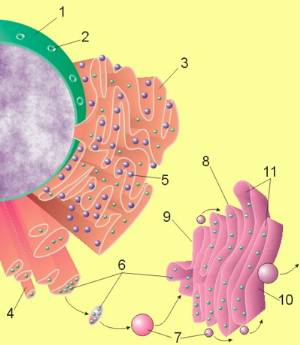Endoplasmic Reticulum
Online Biology Dictionary
|
|

|
| Key to figure: 1. nuclear envelope, 2. nuclear pore, 3. rER, 4. sER, 5. a ribosome attached to rER, 6. macromolecules, 7. transport vesicles, 8. Golgi apparatus, 9. cis face of the Golgi apparatus (the face toward the nucleus), 10. its trans face (the one away from the nucleus), 11. cisternae of Golgi apparatus |
The endoplasmic reticulum (ER) is a large, complex organelle present in eukaryotic cells, the site of lipid and glycoprotein synthesis. The ER lies on the external surface of the nuclear envelope. There are two distinct endoplasmic reticula of which the ER is itself composed, the rough (ribosome studded) ER and the smooth (ribosome-free) ER, respectively abbreviated rER and sER (see the videos on this page to learn about the differences between the rER and sER). Like all other cellular organelles, ERs are membrane-bounded.
Most shared on Macroevolution.net:
Human Origins: Are we hybrids?
On the Origins of New Forms of Life
Mammalian Hybrids
Cat-rabbit Hybrids: Fact or fiction?
Famous Biologists
Dog-cow Hybrids
Georges Cuvier: A Biography
Prothero: A Rebuttal
Branches of Biology
Dog-fox Hybrids